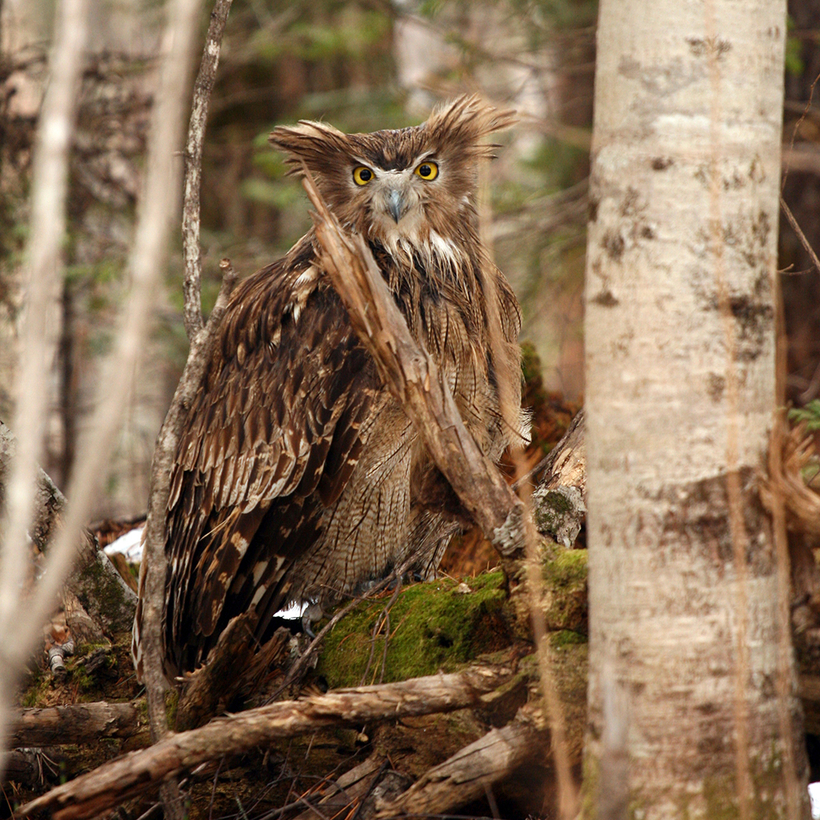When wildlife biologist Jonathan C. Slaght first saw the Blakiston’s fish owl—the largest living species of its kind—it looked to him like a feathered yearling bear. But even that doesn’t capture the magnificence of an owl that looks, at certain angles, a little like a puppet made of yarn, as Slaght describes in his book, Owls of the Eastern Ice, a “floppy goblin,” a “small gray sack of potatoes,” or a “glowering dragon”—the last of these probably having to do with the animal’s six-foot wingspan. The owl is also “a symbol of … wilderness,” he writes, and “a beautiful thought I couldn’t quite articulate.”
But articulate it he does.
Owls of the Eastern Ice is a record of Slaght’s four-year telemetry study in the faraway forests of Primorye, in eastern Russia, to understand fish-owl habitats and make recommendations for protecting them. Readers learn alongside Slaght how the rare birds fish, choose territory, pick a nesting site, and call to each other in a low duet. We also discover that to track, observe, catch, tag, and release fish owls requires not only experience and knowledge but also the patience of a long, flat road. While such science-driven tasks inform the narrative of the book, there exists an undercarriage of study and fieldwork of a less data-driven kind: Slaght’s observations about the human characters he encounters. Both owl and human mystery, we find, are worthy of curiosity and affection.
Eastern Pilgrimage
Sergey Avdeyuk, with his deep knowledge of the forests and fish owls, is the leader of Slaght’s field team and Chaucerian cast, which consists of Tolya Ryzhov, the superstitious, teetotaling photographer who thinks he has superpowers; Shurik Popov, the fixer who could “gut and clean a dozen fish for dinner” without complaint; and Sergey Surmach, a field biologist who provides the equipment and territorial expertise for the group’s prolonged expedition.
As they move through the forests, rivers, and outposts of Russia, they encounter a logger who reminds Slaght of a “torporic bear” and assorted men such as Lësha, a “skinny Russian hunter in an oversized parka,” who had been drinking for “ten or twelve days.” There’s Andrey Katkov, a “stout with the paunch of a Roman hedonist” and a “near-pathological need to talk,” and the American tiger researcher John Goodrich—“tall, blond, and action-figure handsome”—who wears wraparound sunglasses and is seemingly “teleported from the country back roads of the American West.”
The summary of Slaght’s human encounters? “I had learned silence was the best policy,” he writes, especially when it came to “drunken ones, as the most common reaction to meeting a foreigner was demands of communal vodka ingestion to facilitate a lengthy exploration of cultural differences.”
The author “learned silence was the best policy,” especially when it came to drunken encounters.
In the background of this owl-and-human foreground lies the brutal physicality of a remote Russian landscape where bridges are made of ice and roads are a river’s unforeseen path. Slaght and his party face thickly wooded forests they must cut through to get their snowmobile past, rivers of slush they shoot across with speed and faith, floods, tigers, bears, boars, storms, roadblocks, food shortages, and too much vodka. One night, asleep in their tents, they are roused by a grass fire that is licking at the edges of their campsite, which they drive off with buckets of muddy water. “The line between life and death here could be measured in the thickness of river ice,” Slaght writes. And ice could be ambiguous itself.
The book is a svelte guide to a Russia we wouldn’t otherwise see, and also forges an on-the-ground understanding of the region’s past. As they approach Samarga near the Strait of Tartary, they see a bony group of feral horses, descendants from those brought there during Soviet collectivization. Collectivization, however, brought with it a catastrophic famine to the people of Russia, mirrored in the horse the group later finds twitching and dying slowly of starvation.
This violent past precedes a violent present. Overfishing and degraded habitat have ruined massive salmon runs, mining has “decapitated” and “eviscerated” the hills, and big, old trees that house nesting owls are being cut down to make skidder roads. Roads, as we know, always precede civilization, and civilization is a fish owl’s foe.
“What would the owls do if all the big trees were gone?,” Slaght asks. We know the answer.
Kerri Arsenault is the author of the upcoming Mill Town: Reckoning with What Remains


